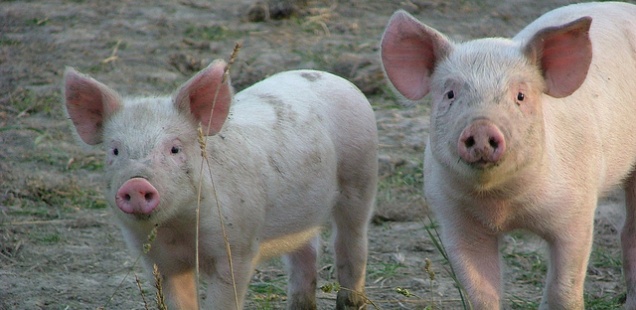Go back around 75 years or so and there was a time when every rural farmhouse had a pig or two in the back garden they were fattening up for the winter to enjoy with their Christmas dinner.
In no time at all pigs almost disappeared from rural Britain to the industrialization and commercialisation of the pig business. Pigs were big business and raised in huge houses by corporate farms who sold directly to supermarkets. These pigs were selected for their quick growing ability in a cramped and almost inhospitable environment.
They aren’t selected for their taste or the quality of their meat like rare breed pigs. And it’s a sad day when pigs are chosen for their profitability as that gives pigs a bad name; this has caused pork to become almost tasteless. It becomes dry, like cardboard and has so many additives that it’s completely unnaturral.
Make a Change – Raise Your Own Pigs
If you’re lucky enough to have eaten home raised pork then you know what proper pork tastes like; it’s juicy, tender and full of flavour. So if you have some land, why not raise a pig or two?
If you’ve decided to take the leap of faith and learn how to raise pigs then the first thing you need to do is choose you’re rare breed of pig such as Tamworth Pigs, Gloucester Old Spots etc. Each pig has different characteristics. Match the breed with your goals and your location. More on that here. And you can also do a search on the internet to find suppliers who will give you all the details you need. Once you have chosen a pig breed and learned about the legal requirements you are ready to go.
Prepare For Your Pigs Arrival
The worst thing you can do is bring the pig home first and then figure out what it needs. If you don’t plan for its arrival, you will get caught short, I guarantee it! The first thing you will need is a good fence, pigs are notorious for being great at escaping. They say if it’s water tight then it’s pig proof so remember that, their curious nature gets them into a whole world of trouble.
Your pig will also need sheltering, it doesn’t have to be fancy, just a three-sided shed will do with tin roofing. It’s best if you can move it should you need to for cleaning and if it gets muddy inside.
It’s also important that it has plenty ventilation so leave one end open. Try build it in a shady spot as pigs can get too hot in the summer so they love somewhere they can cool off.
Electric fences
The best quality pork comes from pigs that have freedom to roam. Keeping them in a pen is both in my opinion kind of cruel and also costs you more money in feed because you prevent the pig from foraging for its own feed.
For this to work an electric fence that spans the perimeter of a pasture works best. Pigs are quick learners so although they may try to escape they soon learn to respect the fance.
Feed
A pig that eats lots of fresh greens and gets plenty of exercise will have more muscle and less fat than a pig standing in a pig sty eating high carbohydrate grains all day.
Although your pig will get plenty of nutrients from foraging, vegetation is not enough for a growing pig so you will need to add a high protein diet.
It’s wise to invest in a balanced feed made especially for growing pigs. Read my thoughts and information on choosing a pig feed supplier and what to buy here.
Potential Health issues When Raising Pigs
Young pigs are often susceptible to getting intestinal worms that can stunt their growth and weaken their immune system.
It’s recommended to worm them at weaning and keep them out on clean pasture, that way they shouldn’t need it again before slaughtering.
Processing The Pig Meat
One of the most frequently asked questions by someone who is planning on raisig pigs is: “How do I eventually get the meat from my pet pig?” (Assuming he’s not just a pet pig, which can be equally rewarding)
Different breeds of pigs will grow at different rates, this can also be effected byhow much you feed but strictly speaking they should be at around 200 pounds by six months of age. If you let it get much over 200 pounds, it will start putting on more fat than meat.
To weigh your pig the best way is to use a special measuring tape that you use to measure your pig and it will guide you through the calculation of determining their weight. Measure it every month so you can keep a close track of things.
You can of course choose to slaughter your own big, there are plenty of guides and books on how to do it, but if you’re not that type of person then you may want to leave it to the professionals and find a local processor.
Why Raise Your Own Pigs?
If you have the land and time, raising your own pork can be very rewarding. You will find that it tastes so much better than supermarket pork and it is free of additives because you ultimately control what goes into your pig.
Quick Checklist for Raising Pigs
- Have you got a draught free shelter?
- Are your fences and buildings escape proof?
- Do you have a water supply, if not, can you get water to your pigs?
- Do you have storage for food and bedding?
- If you plan on eating your pigs where will you get them slaughtered?
And remember as long as you do your homework on how to raise a pig and and are well prepared then pigs are very easy to keep and you will have hours of fun. Hope this helps!
